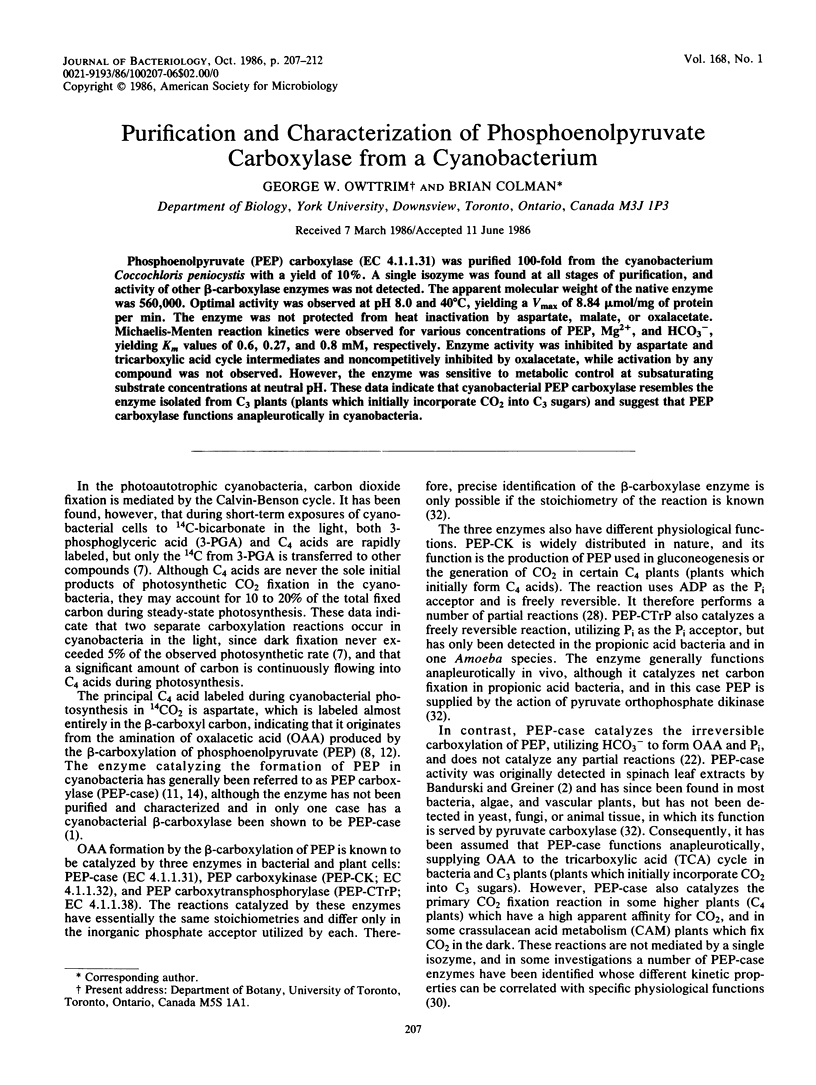Abstract
Phosphoenolpyruvate (PEP) carboxylase (EC 4.1.1.31) was purified 100-fold from the cyanobacterium Coccochloris peniocystis with a yield of 10%. A single isozyme was found at all stages of purification, and activity of other beta-carboxylase enzymes was not detected. The apparent molecular weight of the native enzyme was 560,000. Optimal activity was observed at pH 8.0 and 40 degrees C, yielding a Vmax of 8.84 mumol/mg of protein per min. The enzyme was not protected from heat inactivation by aspartate, malate, or oxalacetate. Michaelis-Menten reaction kinetics were observed for various concentrations of PEP, Mg2+, and HCO3-, yielding Km values of 0.6, 0.27, and 0.8 mM, respectively. Enzyme activity was inhibited by aspartate and tricarboxylic acid cycle intermediates and noncompetitively inhibited by oxalacetate, while activation by any compound was not observed. However, the enzyme was sensitive to metabolic control at subsaturating substrate concentrations at neutral pH. These data indicate that cyanobacterial PEP carboxylase resembles the enzyme isolated from C3 plants (plants which initially incorporate CO2 into C3 sugars) and suggest that PEP carboxylase functions anapleurotically in cyanobacteria.
Full text
PDF





Selected References
These references are in PubMed. This may not be the complete list of references from this article.
- BANDURSKI R. S., GREINER C. M. The enzymatic synthesis of oxalacetate from phosphoryl-enolpyruvate and carbon dioxide. J Biol Chem. 1953 Oct;204(2):781–786. [PubMed] [Google Scholar]
- Bensadoun A., Weinstein D. Assay of proteins in the presence of interfering materials. Anal Biochem. 1976 Jan;70(1):241–250. doi: 10.1016/s0003-2697(76)80064-4. [DOI] [PubMed] [Google Scholar]
- Birmingham B. C., Colman B. Measurement of carbon dioxide compensation points of freshwater algae. Plant Physiol. 1979 Nov;64(5):892–895. doi: 10.1104/pp.64.5.892. [DOI] [PMC free article] [PubMed] [Google Scholar]
- Chen J. H., Jones R. F. Multiple forms of phosphoenolpyruvate carboxylase from Chlamydomonas reeinhardtii. Biochim Biophys Acta. 1970 Aug 21;214(2):318–325. doi: 10.1016/0005-2795(70)90009-7. [DOI] [PubMed] [Google Scholar]
- Coleman J. R., Colman B. Inorganic Carbon Accumulation and Photosynthesis in a Blue-green Alga as a Function of External pH. Plant Physiol. 1981 May;67(5):917–921. doi: 10.1104/pp.67.5.917. [DOI] [PMC free article] [PubMed] [Google Scholar]
- Daley L. S., Ray T. B., Vines H. M., Black C. C. Characterization of Phosphoenolpyruvate Carboxykinase from Pineapple Leaves Ananas comosus (L.) Merr. Plant Physiol. 1977 Apr;59(4):618–622. doi: 10.1104/pp.59.4.618. [DOI] [PMC free article] [PubMed] [Google Scholar]
- Hatch M. D. An assat for PEP carboxykinase in crude tissue extracts. Anal Biochem. 1973 Mar;52(1):280–285. doi: 10.1016/0003-2697(73)90350-3. [DOI] [PubMed] [Google Scholar]
- Hatch M. D. Mechanism of C4 photosynthesis in Chloris gayana: pool sizes and kinetics of 14CO2 incorporation into 4-carbon and 3-carbon intermediates. Arch Biochem Biophys. 1979 Apr 15;194(1):117–127. doi: 10.1016/0003-9861(79)90601-5. [DOI] [PubMed] [Google Scholar]
- Holdsworth E. S., Bruck K. Enzymes concerned with beta-carboxylation in marine phytoplankter. Purification and properties of phosphoenolpyruvate carboxykinase. Arch Biochem Biophys. 1977 Jul;182(1):87–94. doi: 10.1016/0003-9861(77)90286-7. [DOI] [PubMed] [Google Scholar]
- Kenyon W. H., Holaday A. S., Black C. C. Diurnal Changes in Metabolite Levels and Crassulacean Acid Metabolism in Kalanchoë daigremontiana Leaves. Plant Physiol. 1981 Nov;68(5):1002–1007. doi: 10.1104/pp.68.5.1002. [DOI] [PMC free article] [PubMed] [Google Scholar]
- Maruyama H., Easterday R. L., Chang H. C., Lane M. D. The enzymatic carboxylation of phosphoenolpyruvate. I. Purification and properties of phosphoenolpyruvate carboxylase. J Biol Chem. 1966 May 25;241(10):2405–2412. [PubMed] [Google Scholar]
- Miller A. G., Colman B. Active transport and accumulation of bicarbonate by a unicellular cyanobacterium. J Bacteriol. 1980 Sep;143(3):1253–1259. doi: 10.1128/jb.143.3.1253-1259.1980. [DOI] [PMC free article] [PubMed] [Google Scholar]
- Miziorko H. M., Nowak T., Mildvan A. S. Spinach leaf phosphoenolpyruvate carboxylase: purification, properties, and kinetic studies. Arch Biochem Biophys. 1974 Jul;163(1):378–389. doi: 10.1016/0003-9861(74)90489-5. [DOI] [PubMed] [Google Scholar]
- Perl M. Phosphoenolpyruvate carboxylating enzyme in dark-grown and in green Euglena cells. J Biochem. 1974 Nov;76(5):1095–1101. [PubMed] [Google Scholar]
- Ray T. B., Black C. C. Characterization of Phosphoenolpyruvate Carboxykinase from Panicum maximum. Plant Physiol. 1976 Nov;58(5):603–607. doi: 10.1104/pp.58.5.603. [DOI] [PMC free article] [PubMed] [Google Scholar]
- Smith T. E., Balasubramanian K. A., Beezley A. Escherichia coli phosphoenolpyruvate carboxylase. Studies on the mechanism of synergistic activation by nucleotides. J Biol Chem. 1980 Feb 25;255(4):1635–1642. [PubMed] [Google Scholar]
- Ting I. P., Osmond C. B. Multiple forms of plant phosphoenolpyruvate carboxylase associated with different metabolic pathways. Plant Physiol. 1973 Mar;51(3):448–453. doi: 10.1104/pp.51.3.448. [DOI] [PMC free article] [PubMed] [Google Scholar]
- Uedan K., Sugiyama T. Purification and characterization of phosphoenolpyruvate carboxylase from maize leaves. Plant Physiol. 1976 Jun;57(6):906–910. doi: 10.1104/pp.57.6.906. [DOI] [PMC free article] [PubMed] [Google Scholar]


